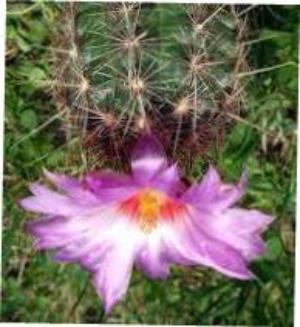Mexican woollyhead
(Thelocactus bicolor flavidispinus)

Description
Thelocactus bicolor, commonly known as the Mexican woollyhead or bicolor lace cactus, is a small and slow-growing cactus species native to Mexico. It belongs to the family Cactaceae, which includes around 175 genera and 2,000 species of cacti, ranging from the tiny and spherical to the towering and columnar. Description Thelocactus bicolor is a small and low-growing cactus that typically grows up to 4-5 inches (10-13 cm) tall and 4-6 inches (10-15 cm) in diameter. It has a solitary, hemispherical or slightly cylindrical shape with a flattened top and a dense covering of white or yellowish spines that help protect it from predators. The spines can be up to 2 inches (5 cm) long and are arranged in clusters of up to 12. The stem of the plant is green or blue-green, and it has a woolly-looking crown of fine white hairs that give it its common name. The flowers of the plant are quite striking, with bright pink or magenta petals and a yellow or red center. They are typically 1-2 inches (2.5-5 cm) in diameter and bloom in late spring or early summer. Distribution and Habitat Thelocactus bicolor is native to the semi-arid regions of central and northern Mexico, where it can be found growing in rocky and sandy soils, on hillsides and slopes, and in desert scrub and grasslands. Its natural range includes the states of Coahuila, Nuevo León, San Luis Potosí, and Tamaulipas, among others. The plant is adapted to the harsh conditions of its natural habitat and is able to survive long periods of drought and extreme temperatures. It is often found growing in association with other cacti and succulent species, such as Agave, Yucca, and Opuntia. Cultivation Thelocactus bicolor is a popular ornamental plant that is widely cultivated around the world for its striking appearance and low-maintenance requirements. It is often grown in pots or containers, where it can be easily moved around and displayed. The plant requires well-draining soil and plenty of sunlight to thrive. It is able to tolerate some degree of shade, but too much shade can cause it to become leggy and weak. It is also important to avoid overwatering the plant, as this can lead to root rot and other problems. Propagation Thelocactus bicolor can be propagated from seed or by stem cuttings. To propagate by seed, the seeds should be sown in well-draining soil and kept warm and moist until they germinate. It can take several weeks or even months for the seeds to sprout, so patience is key. To propagate by stem cuttings, a healthy stem can be cut off from the parent plant and left to dry for several days. Once the cut end has calloused over, the cutting can be planted in well-draining soil and watered sparingly until it begins to grow roots. Uses Thelocactus bicolor is primarily grown as an ornamental plant, both indoors and outdoors. Its unique appearance and ease of cultivation make it a popular choice for cactus collectors and enthusiasts. It is also sometimes used in xeriscaping, a landscaping technique that emphasizes the use of drought-tolerant plants. In Mexico, some indigenous communities have used the plant for medicinal purposes, including the treatment of skin conditions, fever, and gastrointestinal problems. However, there is limited scientific evidence to support these uses, and the plant should not be used as a substitute for professional medical advice or treatment. Conservation Status Thelocactus bicolor is not currently considered to be threatened or endangered, although it is listed as a species of least concern on the International Union for Conservation of Nature's (IUCN) Red List. However, like many cactus species, it is at risk from habitat loss and illegal collection for the horticultural trade. In addition, climate change and extreme weather events such as drought and flooding can also have a significant impact on the plant's survival in the wild. It is therefore important to conserve and protect the natural habitats of Thelocactus bicolor and other cactus species, both for their ecological value and for their cultural and aesthetic significance. Conclusion Thelocactus bicolor is a fascinating and beautiful cactus species that is well-adapted to the harsh conditions of its natural habitat in Mexico. Its woolly crown of fine white hairs, bright pink flowers, and dense covering of spines make it a popular choice for cactus collectors and enthusiasts around the world. However, it is also important to conserve and protect the natural habitats of the plant to ensure its long-term survival and to maintain the ecological and cultural values of these unique ecosystems.
Taxonomic tree:







